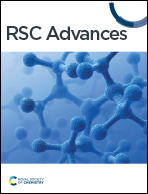Association thermodynamic parameters for nano Cu(NO3)2·2.5H2O with ligands at different temperatures
Abstract
Association thermodynamic parameters are important because they give information about the nature of ion–ion interaction in solution, the dielectric constant of the medium and the intermolecular hydrogen bonding between the solvent molecules. The different association thermodynamic parameters for nano copper(II) nitrate hemi pentahydrate in the presence of 4,6-diacetylresorcinol and 4,6-bis(1-hydrazonoethyl)benzene-1,3-diol as ligands were calculated. Conductance measurements were used in different concentrations of binary mixed solvents (DMF and water) at different temperatures, 293.15, 303.15, 313.15 and 323.15 K. A comparison between association thermodynamic parameter data such as association constants (KA), degree of dissociation (α), free energies of association (ΔGA), enthalpies of association (ΔHA) and entropies of association (ΔSA) in the case of using the two ligands was done. Different calculated thermodynamic parameters indicate that the association is more favorable with 4,6-diacetylresorcinol as a ligand than 4,6-bis(1-hydrazonoethyl)benzene-1,3-diol due to the large size of 6-bis(1-hydrazonoethyl)benzene-1,3-diol.


 Please wait while we load your content...
Please wait while we load your content...